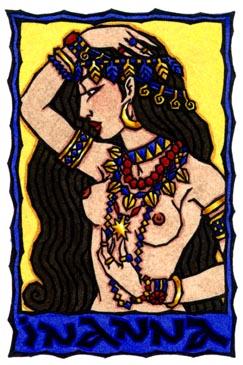We're just days away from a major Wiccan sabbat, Lughnasadh (or Lammas), on (or around) August 1. Lughnasadh (LOO-na-sahd) falls halfway between the summer solstice and the fall equinox, both minor sabbats, and it is the first of the three harvest festivals. (The second is Mabon, or the fall equinox, and the third is Samhain, or Halloween.) I admit that I don't observe the sabbats with any regularity, and sometimes my observation comprises little more than a walk and a silent appreciation. Other times I host a party or ritual, or attend a public ritual. One year I went to a nature center and did a solitary 24-hour retreat for Lughnasadh, and another year I helped friends harvest their garlic in a pouring rain. But Lughnasadh doesn't have much personal meaning for me - not the way that Imbolc and Samhain do, for example. I thought I would take some time here to think "out loud" about the meaning of Lughnasadh.
The sabbats observed by many contemporary Pagans originated in the British Isles and bear Celtic names. That the sabbats are celebrated when they are makes sense, since they're solar holidays and thus depend on the position of the sun: the solstices, the equinoxes, and the days equidistant between those. But Paganism is a religion based in local practices, so it doesn't necessarily make sense to call the sabbats by their Celtic names, nor to give them the same meaning that the Celts did. I like the sound of the word Lughnasadh, so I use that word even though I don't feel particular affinity for the Celtic god Lugh, a solar god, a storm god, a communicator, and/or a trickster. Since some of my ancestry is in fact Celtic (Scottish and Irish), I don't mind using the Celtic names more generally. But like a lot of modern Pagans, and to the chagrin of some, my pantheon is a mixed one.
Where I live, in the northeastern U.S., the weather and agricultural patterns aren't very different from those in Britain, so I also tend to use the standard meanings assigned to the Sabbats. Thus Lughnasadh is the early harvest for me, the time when bounty really begins to flow from the local organic farms, and when garlic, herbs, grains, and seeds are harvested and dried to last through the winter. It is traditional at Lughnasadh to bake bread (but it's way too hot here for that), to make corn dollies (something I have no interest in doing), and to burn a straw man in acknowledgement of the grain god's sacrifice of himself in the harvest (I'm not about to do that by myself). What, then, can I do to observe the sabbat and make it meaningful for me?
An excellent resource for observing the sabbats is the book Circle Round, by Starhawk, Diane Baker, and Anne Hill. Even though the book is written for those raising children in Goddess traditions, I find it useful just for me, which makes sense since I am myself am a child in the Craft (and I suspect that if I were to have children and raise them in the Craft, I'd learn a lot more about my tradition!). Here is some of what they write:
Lammas is a time to think about our hopes and fears. We hope that we'll be able to pick and eat what we've worked so hard to grow - but a lot could still happen. ...To harvest, we must cut down the plants we've tended so carefully. To people who live close to the earth and growing things, this almost feels like killing a person. We mourn and grieve for the spirit of the grain and the green things. We honor them because they give us life by letting us eat them. We feel sad that summer must end for us to reap the harvest. But we feel happy, too, thinking about all the good things we'll have to eat! ...Lammas teaches us to feel sad and happy.
Because Lammas comes at the season when the grain and many fruits first begin to ripen, it was always a time for special offerings. The first fruits to ripen and the first grain that was ready to reap were considered to be especially sacred, as if they carried within them the spirit of the Goddess herself. [Note, too, that to sacrifice the first fruits is an act of faith that the Goddess will provide further.] The bees are very active now, and their sweet, golden honey is a symbol of this sunny time.
At the summer solstice we learned to be generous, to sow many seeds. Now, at Lammas, we must learn to be protectors and nurturers of what we've planted. ...In ancient Ireland and throughout the British Isles, Lammas was a time for great fairs and markets. It marked a time of sacred peace.
Subscribe to:
Post Comments (Atom)

No comments:
Post a Comment